Tech Report
Mixing dilatant materials
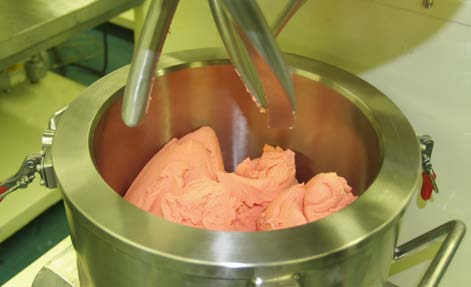
Technology Brief
Dilatant materials pose a unique mixing challenge due to their very nature: the greater the shear forces applied to the material, the more resistance is encountered. Heavy-duty, high-torque double planetary mixers operated under comparatively low speeds are ideal for processing shear-thickening mixtures.
Dilatant materials
Dilatant or shear-thickening materials are mixtures that exhibit an increase in apparent viscosity as the rate of shear increases. Typically made up of a high concentration of solids (polymers, metal or oxides) dispersed in liquid, these materials behave like a fluid under relatively low shear conditions but transition into a more solid-like behavior once greater stress is applied. At a certain point, when shear forces (those that push the particles together) become larger in magnitude than repulsive interparticle forces, the molecules shift from a layered to a disordered structure, causing an increase in viscosity. Generally, this process is reversible - when force from the stress dissipates, viscosity decreases and the material behaves like a fluid again.
The greater the shear applied to a dilatant material, the more resistance is encountered. When subjected to particularly high levels of stress or impact, highly dilatant materials can quickly become extremely rigid. It is this very property which makes mixing dilatant formulations a unique challenge.
Low shear mixing
It stands to reason that the appropriate mixer for processing dilatant materials must be comparatively low speed and low shear. Yet, mixer speed cannot be too slow or else it won't be able to completely disperse the solid component. Some degree of shear is required for efficient mixing; therefore, the mixer must also have enough torque to accommodate the inevitable shear-thickening effects.
Various mixer configurations deliver low shear mixing, from simple propellers and paddle blades to more complex counter-rotating agitators. However, these devices face a common limitation which is viscosity. Especially when the starting liquid already possesses considerable viscosity, agitators with a fixed axis of rotation can be ineffective at solids dispersion. As more solids are added and concentration rises, dilatant behavior will set in making it more difficult for the agitator to produce adequate flow.
Double planetary mixer
he logical solution is to utilize agitators that move through the batch regardless of product flow. That is the forte of the double planetary mixer (DPM). It moves material by rotating two identical blades on their own axes as they orbit on a common axis. The blades continuously advance along the periphery of the mix vessel, removing material from the walls and transporting it towards the interior.
Low speed but powerful and thorough
The double planetary mixer is a robust machine capable of handling heavy materials as high as 8 million cP* - from dense powders to highly filled slurries and composites. Powerful, variable-speed drives and heavy construction enable this mixer to deliver high torque throughout its entire speed range.
The comparatively low speed but thorough folding action imparted by the planetary blades is ideal for processing dilatant materials. The DPM can easily blend large amounts of solids into a viscous liquid vehicle and continue the dispersion process even after dilatant effects have set in. After only 36 revolutions, the blades have passed through every point within the vessel, physically contacting the entire batch.
Planetary Mixer Blade Designs
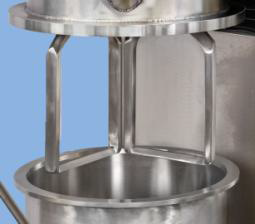
Double Planetary Mixer with Rectangular Stirrers
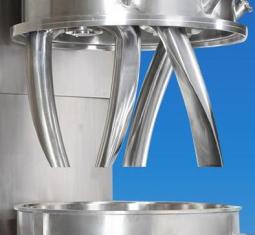
Double Planetary Mixer with High Viscosity "HV" Blades

PowerMix Planetary Disperser with Rectangular Stirrer, Dual-Blade High Speed Disperser and Sidewall Scraper Arm
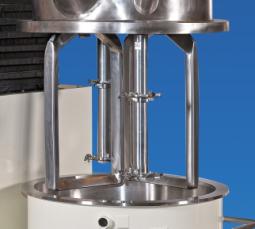
Planetary Dual Disperser with Two Rectangular Stirrers and Two Disperser Shafts
Sample Application: Silica Dispersions
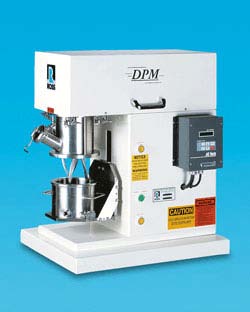
A Ross Heavy-Duty Double Planetary Mixer equipped with High Viscosity "HV" blades is being used in a research laboratory to prepare dispersions of silica in a polymer matrix. The material becomes very dilatant at high silica concentrations. Conventional stirrers have been tested but these did not work well at concentrations above 40% silica by weight.
The mix vessel supplied with the laboratory DPM is jacketed for heating purposes and includes a sidewall thermocouple for monitoring temperature. The HV blades feature a precisely angled helical contour and pass each other in a smooth slicing motion, preventing any torque spikes during the mixing cycle.
End-use applications of dilatant dispersions include shock-absorbent sports equipment, protective liners for vehicles, and soft body armor.